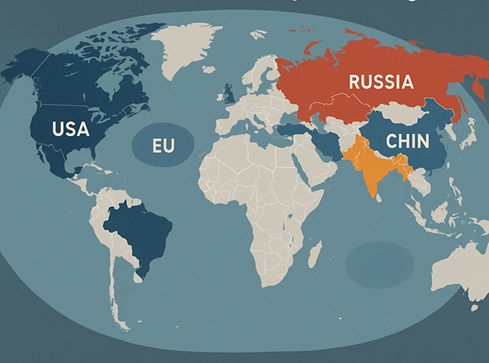| (Mains, General Studies Paper-2: Bilateral, regional and global groups and agreements concerning India and/or affecting India's interests; Impact of policies and politics of developed and developing countries on India's interests; Overseas Indians) |
Context
Global geopolitics is changing and traditional power alignments are changing due to conflicts, economic instability and changing alliances. India needs to deal with these changes to safeguard its interests.

Key Global Trends
- Declining unipolarity: US influence challenged by rise of China and assertiveness of Russia
- Official visit of Russian President to China on the occasion of 75th anniversary of establishment of diplomatic relations between China and Russia
- Purchase of crude oil from Russia by various countries despite US sanctions like CAATSA
- Fragmented multilateralism: WTO, UN and other institutions are facing a crisis of credibility and effectiveness.
- Not able to play any effective role in Russia-Ukraine conflict and Israel-Palestine conflict.
- Regional conflicts: Ukraine war, West Asia tensions and Indo-Pacific militarization are increasing pressure on global governance.
- Economic nationalism: Supply chain fragmentation, technology restrictions and protectionism.
- US imposing high import duties on various countries.
Reaction of various countries and groups towards India
Operation Sindoor: Real test of diplomacy
- Pakistan based terrorist groups involved in Pahalgam attack declared as terrorists by UN (April 22, 2025).
- India’s decisive military retaliation received mixed global reactions.
- US President Donald Trump’s claim of brokering a ceasefire through trade benefits highlighted the narrative control challenges.
- However, Indian Parliament completely rejected Trump’s claim.
- US designates TRF as a global terrorist organisation. Also, UN Security Council monitoring team acknowledged TRF's role in Pahalgam attack.
Trade conflict with US
- US imposes 25% tariff on Indian goods on the day of India-US NISAR satellite launch.
- Threat of tariff hike on Russian oil imports despite Russia-related imports.
- ‘America First’ policies discouraging US companies from investing in India.
- Disproportionate focus on Indo-Pacific due to US re-engagement with China (e.g. allowing Nvidia chip sales to China).
Tense relations with EU
- EU sanctions on India's Vadinar refinery (Rosneft stake) target energy security.
- EU carbon border tax and digital trade barriers still in place.
- EU countries continue to import Russian oil/gas while urging India to cut Russian supplies.
- India hopes that the recent India-UK trade deal may put pressure on the EU to reduce various demands.
China’s regional activities
- Promoting new regional groupings excluding India (China-Pakistan-Bangladesh initiative)
- Support to Pakistan during Operation Sindoor
- Strategic projects near Indian borders (revival of Lalmonirhat airbase in Bangladesh, renaming of places in Arunachal Pradesh, construction of huge dam on Yarlung Zangbo)
- Taking advantage of trade surplus and supply chain dependencies (rare earth elements, API, tunnelling machines)
Challenges to regional and global balance
- Improvement in US-Pakistan relations; praise of Pakistan on anti-terror measures, insensitivity to India’s concerns.
- US role in regime change in Bangladesh and instability in Myanmar affects India's Northeast.
- India's silent stance on Israel-Gaza and Israel-Iran conflicts threatens to reduce geopolitical influence.
- Strategic autonomy is being tested as economic and technological flows of conflicts reshape it.
India's strategic position
- Balancing strategy: India has tried to maintain relations with both Western powers and Russia, such as Quad, BRICS, SCO. Participation in
- Strategic autonomy: Prioritising independent foreign policy to avoid alliance traps
- Economic diplomacy: Leveraging the outcomes of G-20 presidency, trade diversification and supply chain initiatives
- Global South leadership: Advocating for equitable global governance, debt relief and climate justice
- Focus on security: Strengthening engagement in the Indo-Pacific, defence partnerships and border preparedness
Challenges for India
- Dealing with US-China rivalry without economic damage
- Maintaining ties with Russia amid Western sanctions
- Ensuring access to energy and technology in fragmented markets
- Managing border tensions with Pakistan and China
Way forward
- Recalibrating global engagemen
- Moving away from passive ‘non-involvement’ in global conflicts to selective, interest-driven activism
- An assertive stance in global crises can enhance reciprocity among partners
- Strengthening multi-alignment
- Emphasis should be laid on strengthening relations with BRICS, SCO, East Asia forums as well as Quad and I2U2.
- Consider reviving RIC to balance US-China relations.
- Protection of economic interests in trade wars
- Negotiate early bilateral trade agreements with the US to protect market access
- Use UK trade deal influence in EU negotiations
- Countering China’s regional pressure
- Consider enhancing regional diplomacy with Bangladesh, Nepal, Maldives and ASEAN to reduce China’s influence.
- There is a need to accelerate border infrastructure and river management diplomacy with neighbours.
- Energy and technology security
- Diversify sources of rare earths and critical minerals
- Ensure strategic technology partnerships beyond the US-EU



